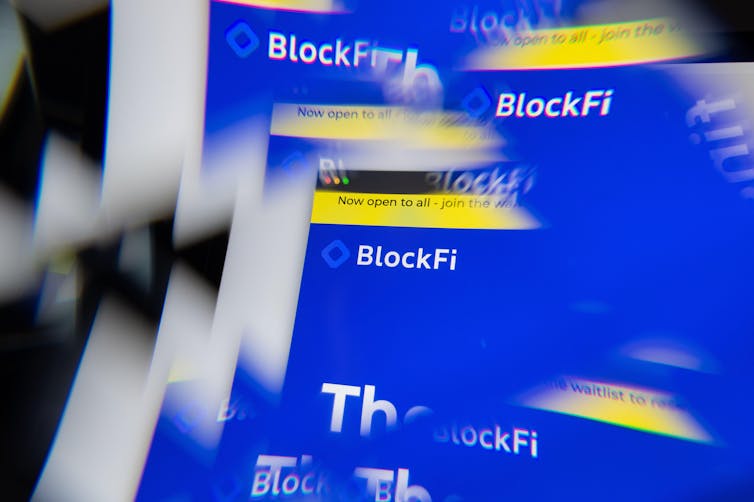
Matthew Shillito, Lecturer in Law, University of Liverpool.
____
Leading crypto banks such as BlockFi and Nexo are attracting a lot of attention. Customers can earn an APY (annual percentage yield) of up to 12%, dwarfing high-street savings accounts, whose interest rates are sub-1%. But before you rush to transfer your hard-earned savings, there’s some important things to be aware of.
First you need to realise what these banks are offering interest on. Apart from Nexo, which pays up to 12% interest on pounds, US dollars and euros, most crypto banks only allow customers to save in cryptocurrencies such as bitcoin and ethereum, or stablecoins like Tether or USDC which trade one for one with the US dollar.
Their highest rates are paid on stablecoins: for example, Nexo pays up to 12% on USDC and Tether but 8% on bitcoin, while BlockFi pays 8.6% on USDC, 9.3% on Tether and 5% on bitcoin. In other words, you could change USD 1,000 into USDC 1,000, leave it in a BlockFi account for a year, then theoretically withdraw USD 1,086.
Because most crypto banks only deal in cryptocurrencies or stablecoins, you must first transfer your money into this form. This can be done via a crypto exchange such as Coinbase or Binance, or in a more limited way via a crypto bank: for example, you can transfer US dollars to BlockFi and they automatically convert them into another stablecoin called Gemini USD (also paying 8.6% APR).

Skorzewiak
Most crypto banks offer the opportunity to trade your money within their platform – for example from Gemini USD to bitcoin. But despite boasting of zero fees for this facility, the rates are not necessarily the best. BlockFi notes that its cost of purchasing crypto may be 1% higher than the market price.
If you save in cryptocurrencies, the interest rates also drop significantly the more you hold. On BlockFi, for example, the 5% bitcoin rate is only for deposits up to 0.5 bitcoin. For higher amounts it falls to 2%, and ultimately 0.5%.
Some crypto banks also offer their best rates for interest payments in their own cryptocurrency. For example, the 12% APR for Tether and USDC from Nexo is only for those being paid in Nexo tokens. Nexo tokens are not stablecoins, and go up and down in value. For interest payments in Tether or USDC, the rate is 10%.
Finally, no crypto-bank interest rates are guaranteed for any length of time. So while quoting an annual rate, it can fluctuate from day to day.
The business model
Nonetheless, the rates are very high. So how do these banks do it?
A crypto bank’s basic model is to borrow capital at the interest rate it pays depositors, and then to lend it at a higher rate. Crypto banks seek to safeguard their position in two key ways. First, by lending out less than they have in deposits. Second, they make borrowers put up collateral for their loan. This involves a loan-to-value (LTV) calculation for working out how much collateral is required to secure a loan. For example, BlockFi reserves the right to liquidate collateral as soon as it reaches 80% LTV.
To borrow USD 5,000 from BlockFi, you currently need to put up BTC 0.25, which is currently valued at USD 9,448. If that bitcoin value fell to USD 6,250, the bank would sell some of your collateral to return the LTV to a healthy level.
In good times, this is a business model that can bring significant revenue. No doubt high-street banks could offer higher savings rates too, but they use some of that saving to be more competitive on their lending rates instead.
But as far as the crypto banks are concerned, it is unclear what would happen if either there was a sudden and prolonged crash in the crypto market such that these banks’ deposits were worth significantly less than what they had lent out, or if borrowing dried up.
If one of the above scenarios were to play out, then unlike with your savings account at a high street bank, your crypto savings are not insured. BlockFi for instance is based in the US, and is not insured by the Federal Deposit Insurance Corporation (FDIC) nor the Securities Investor Protection Corporation (SIPC), meaning recovering funds is much more difficult if the bank becomes insolvent.
BlockFi also notes in its terms of service that where it or third-party partners experience cyber-attacks, extreme market conditions, or other operational or technical difficulties, they may immediately halt transfers or withdrawals of cryptocurrency either temporarily or permanently.
They will also not be liable for any loss or damage incurred as a result. This is particularly troublesome as it gives wide discretion for a crypto bank to not return your funds on demand, holding on to them where market conditions dictate (it should be said that BlockFi depositor funds are held in cold storage by major exchange Gemini and should at least be relatively safe from hacks). Other operators such as Celsius and Nexo don’t have such terms, but this just leaves their stance on such positions unclear.

Casimiro/Alamy
There has also been some controversy around some stablecoins. For example, there have been questions about to what extent Tether’s operators have US dollar reserves to ensure the one-for-one rate holds. This makes it concerning that customers are being induced into holding such coins to access the highest interest rates. Aside from doomsday scenarios, there are also limits around withdrawals in terms of volume and regularity, with fees paid for transacting beyond these confines.
As with the wider crypto market, it seems willingness to engage in this area is dependent on an individual’s risk appetite. If you’re willing to hand over your crypto to a bank for a profit, then you open yourself up to losing it for good. If you are prepared to accept that risk, and are willing to hold your funds and not treat this like a current account, then a crypto-bank savings account might be for you.![]()
This article is republished from The Conversation under a Creative Commons license. Read the original article.
____
Learn more:
– DeFi Has Had a Strong 2021, Driven By New Trends & Paradigms
– NFT as Collateral Coming to Aave – CEO
– Coinbase Mulls Ethereum Collateral Amid Lending Program Expansion
– Sequoia-Backed Onchain Custodian To Set Up New Crypto Lending Business
– WBTC: Where Bitcoin Meets DeFi
– Apparent BlockFi Fat Finger Gaffe Sees Users ‘Credited BTC 701’
– BlockFi Valued at USD 3B Following USD 350M Round
– Nexo To Launch New Services, Eyes Decentralization As It Aims To Become A Bank
Credit: Source link











































































































































